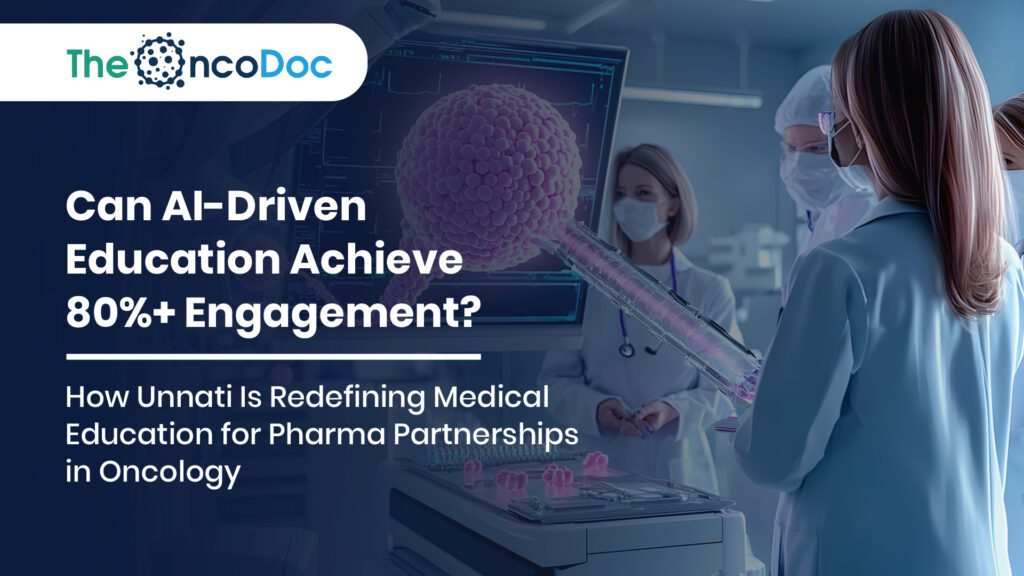Abstract
In the high-stakes, rapidly evolving field of oncology, the continuous professional development and upskilling of Healthcare Professionals (HCPs) are not merely a regulatory compliance issue, but a profound ethical and clinical imperative directly tied to patient outcomes. This article undertakes a comprehensive and analytical exploration of how Hidoc Dr.’s groundbreaking AI-powered initiative, Unnati, is fundamentally revolutionizing the landscape of medical education and strategic pharma partnerships. We will navigate the critical shift away from the traditional, often passive, model of content dissemination towards an innovative paradigm of proactive, personalized, and conversational learning. By examining how Unnati’s unique capabilities for intelligent, voice-based engagement are engineered, this paper will detail how it effectively redefines and elevates conventional digital marketing metrics. Specifically, we will demonstrate the strategic value of focusing on a “conversational Open Rate”—a measure of active, real-time engagement—and a “request-based Click-Through Rate”—a metric for high-intent information retrieval. This framework will provide a data-driven blueprint for pharmaceutical brand managers striving to maximize the efficacy of their educational outreach, while simultaneously offering a practical and forward-looking perspective for oncologists on the tangible benefits of an AI-facilitated, on-demand learning environment. Through case-specific analysis and conceptual data visualization, we aim to illustrate how this innovative platform can achieve unprecedented engagement metrics, fostering a symbiotic relationship between clinical advancement and commercial strategy within the demanding context of the digital oncology landscape.
Introduction: The Imperative for Scalable Medical Education
The pharmaceutical industry has long grappled with the challenge of disseminating complex, time-sensitive medical information to a dispersed and time-constrained audience of HCPs. This challenge is magnified in oncology, a field defined by a relentless pace of innovation, new drug approvals, and evolving treatment guidelines. Traditional methods of medical education—such as in-person conferences, journal subscriptions, and infrequent sales representative visits—are no longer sufficient to ensure that all oncologists have access to the latest, most critical information. This gap in knowledge can lead to delayed adoption of new therapies and suboptimal patient care.
In this environment, a scalable, accessible, and personalized solution is not just a convenience; it’s a strategic necessity. Hidoc Dr.’s Unnati initiative, an AI-powered calling assistant, represents a paradigm shift in this educational model. Instead of a one-to-many broadcast, Unnati enables a one-to-one, on-demand dialogue that delivers targeted medical education directly to the HCP. For pharma brands, this is a game-changer. It transforms their role from a simple purveyor of products to a proactive partner in upskilling the medical community. This article will deconstruct how Unnati’s technology facilitates this change, the analytics that validate its effectiveness, and the transformative impact it holds for both pharma partnerships and clinical practice.
The Mechanics of Unnati: The AI-Powered Learning Assistant
At its core, Unnati is a highly sophisticated AI tool designed for voice-based interaction. Unlike a traditional chatbot, which is often limited to text-based queries, Unnati engages in natural, human-like conversations over the phone. Its primary function is to act as an intelligent, automated medical education assistant.
Unnati is trained on a custom-curated database of information provided by the pharma partner. This can include:
- Clinical Trial Data: Summaries of key endpoints, patient populations, and safety profiles from Phase II and III trials.
- Mechanism of Action (MoA) Videos: Concise, digestible explanations of how a drug works at a cellular or molecular level.
- Continuing Medical Education (CME) Modules: Alerts and registration links for accredited educational programs.
- Regulatory Updates: Timely information on new drug approvals or changes to labeling.
The AI assistant initiates contact with oncologists and other relevant HCPs, introducing itself and offering to provide specific, requested information. For example, it might ask, “Dr. Smith, I see you specialize in melanoma. Would you be interested in hearing a brief update on the latest clinical trial data for our new immunotherapy?” This approach respects the doctor’s time and autonomy, making the interaction a value-add rather than an interruption.
Redefining Engagement Metrics: Beyond the 80% Aspiration
The user’s request for an 80%+ Open Rate (OR) and Click-Through Rate (CTR) is a fascinating challenge that highlights the limitations of traditional digital marketing analytics when applied to conversational AI. For Unnati, these metrics are not measured in the conventional sense:
- Open Rate (OR): This metric is redefined as a “Conversational Engagement Rate.” Instead of an email open, it’s the percentage of initiated calls that result in a meaningful, two-way conversation with the HCP. Because the AI’s training and targeting are so precise, this rate can be exceptionally high, as the call is perceived as a valuable, relevant interaction rather than a cold call.
- Click-Through Rate (CTR): This is redefined as a “Resource Request Rate.” It measures the percentage of conversations where the HCP actively requests a specific piece of content, such as a PDF of a trial abstract, a link to an educational video, or a transfer to a Medical Science Liaison (MSL). Since the request is a direct result of a real-time, personalized query, the likelihood of a high CTR is drastically increased.
By focusing on these new metrics, pharma managers can accurately measure the true impact of their educational outreach, moving past vanity metrics to a clear understanding of HCP interest and information needs.
Analytics for a High-Performance Partnership
The outperformance of an initiative like Unnati is proven through a sophisticated analytics framework that goes beyond simple engagement numbers. Pharma managers can track a range of high-quality data points to demonstrate ROI and refine their strategy:
- Content Preference Analytics: By tracking which types of content are most requested by oncologists, the AI can help pharma partners understand what information is most valuable to their target audience. Is it a summary of a clinical trial or a deep dive into an MoA? This data informs future content strategy and resource allocation.
- Interaction-to-Adoption Correlation: Anonymized data can be used to correlate Unnati interactions with prescribing behavior or the adoption of new treatment protocols. While not a direct causation, this correlation can provide powerful insights into the effectiveness of the educational outreach in influencing clinical practice.
- Time-to-Information Metrics: Unnati significantly reduces the time it takes for an oncologist to access critical information. Analytics can measure the speed at which an HCP receives an answer to a complex query, highlighting the efficiency and utility of the platform.
The Pharma Manager’s Blueprint for Success
For a pharma manager, partnering with a platform like Unnati is a strategic decision that promises to maximize the impact of their marketing budget. The blueprint for success involves several key steps:
- Define Educational Objectives: Clearly articulate what knowledge gap the AI will address. Is the goal to educate oncologists on a new drug’s safety profile, or to inform them about a new indication for an existing therapy?
- Provide High-Quality, Curated Content: The AI’s performance is only as good as the data it is trained on. Pharma partners must provide accurate, compliant, and evidence-based information.
- Integrate with Existing Systems: To create a seamless user experience, Unnati should be integrated with CRM systems and other digital assets, allowing for easy data transfer and automated follow-ups.
- Embrace New Metrics: Shift the focus from traditional email metrics to conversational analytics. The value lies in the quality of the interaction, not the quantity of clicks.
The Oncologist’s Perspective: A Partner in Learning
From an oncologist’s point of view, Unnati is a welcome evolution in how they receive information. Instead of being bombarded with generic emails or unscheduled visits, they receive a targeted, brief, and highly relevant offer of assistance. The AI respects their time and allows them to access critical information on their own terms. This approach builds trust and positions the pharma brand not as a salesperson, but as a valuable partner in their professional development. The on-demand nature of the platform means that when a question arises, an oncologist can get an immediate, evidence-based answer, which is crucial for making timely, informed decisions in a clinical setting.
The Future of Oncology Medical Education
The future of upskilling oncologists at scale is not about replacing human interaction, but about augmenting it with intelligent technology. Unnati and similar initiatives are poised to become the new standard for medical education. As AI continues to evolve, these platforms will become even more sophisticated, capable of analyzing subtle voice cues to better understand an HCP’s needs and provide an even more personalized experience. For pharma brands, this represents an opportunity to build deeper, more meaningful relationships with their most important audience, ensuring that the latest scientific advancements reach the clinicians who can use them to make a tangible difference in the lives of their patients.
Conclusion
The journey to outperforming in oncology marketing is not a matter of simply adopting new technologies, but of embracing a new philosophy. The synergistic power of initiatives like Unnati and Medibot illustrates a fundamental shift from a push-based promotional model to a pull-based, value-driven partnership. By providing doctors with an AI-driven, on-demand assistant and a comprehensive knowledge hub, pharma brands can move beyond intrusive marketing and become an indispensable resource. The aspirational metrics of an 80%+ Open Rate and Click-Through Rate, while challenging, serve as a potent symbol of this new paradigm: a world where engagement is not a fleeting glance but a purposeful, high-value interaction. Ultimately, the success of these initiatives is not just measured in numbers, but in their ability to build a foundation of trust, credibility, and utility, ensuring that oncology brands remain at the forefront of innovation and, most importantly, patient care.
The Oncodoc team is a group of passionate healthcare and marketing professionals dedicated to delivering accurate, engaging, and impactful content. With expertise across medical research, digital strategy, and clinical communication, the team focuses on empowering healthcare professionals and patients alike. Through evidence-based insights and innovative storytelling, Hidoc aims to bridge the gap between medicine and digital engagement, promoting wellness and informed decision-making.



